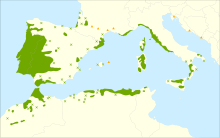Cork oaks
| Cork oak | |
|---|---|
 |
|
| Cork oak in Christchurch Botanic Gardens | |
| Scientific classification | |
| Kingdom: | Plantae |
| (unranked): | Angiosperms |
| (unranked): | Eudicots |
| (unranked): | Rosids |
| Order: | Fagales |
| Family: | Fagaceae |
| Genus: | Quercus |
| Section: | Cerris |
| Species: | Q. suber |
| Binomial name | |
|
Quercus suber L. 1753 |
|
 |
|
| Distribution map | |
| Synonyms | |
|
List
|
|
Quercus suber, commonly called the cork oak, is a medium-sized, evergreen oak tree in the section Quercus sect. Cerris. It is the primary source of cork for wine bottle stoppers and other uses, such as cork flooring and as the cores of cricket balls. It is native to southwest Europe and northwest Africa. In the Mediterranean basin the tree is an ancient species with fossil remnants dating back to the Tertiary period.
It grows to up to 20 m (66 ft), although it is typically more stunted in its native environment. The leaves are 4 to 7 cm (1.6 to 2.8 in) long, weakly lobed or coarsely toothed, dark green above, paler beneath, with the leaf margins often downcurved. The acorns are 2 to 3 cm (0.79 to 1.18 in) long, in a deep cup fringed with elongated scales.
The cork oak forest is one of the major plant communities of the Mediterranean woodlands and forests ecoregion.
Natural stands of cork oak can support diverse ecosystems. For example, in parts of northwestern North Africa, some cork oak forests are habitat to the endangered Barbary macaque, Macaca sylvanus, a species whose habitat is fragmented and whose range was prehistorically much wider. In Western Europe, particularly in Portugal and Spain, the cork oak forests are home to endangered species such as the Iberian lynx, the most critically threatened feline in the world.
...
Wikipedia
